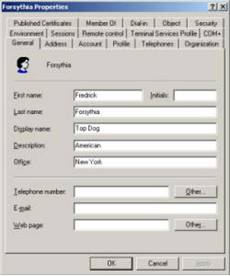LDAP Attributes
From Business Process Management, BPM and Workflow Automation Wiki | BizAgi BPMS
LDAP Attributes
|
LDAP Attribute |
Example |
|
CN - Common Name |
CN=Guy Thomas. Actually, this LDAP attribute is made up from givenName joined to SN. |
|
description |
What you see in Active Directory Users and Computers. Not to be confused with displayName on the Users property sheet. |
|
displayName |
displayName = Guy Thomas. If you script this property, be sure you understand which field you are configuring. DisplayName can be confused with CN or description. |
|
DN - also distinguishedName |
DN is simply the most important LDAP attribute. CN=Jay Jamieson, OU= Newport,DC=cp,DC=com |
|
givenName |
Firstname also called Christian name |
|
homeDrive |
Home Folder: connect. Tricky to configure |
|
name |
name = Guy Thomas. Exactly the same as CN. |
|
objectCategory |
Defines the Active Directory Schema category. For example, objectClass = Person |
|
objectClass |
objectClass = User. Also used for Computer, organizationalUnit, even container. Important top level container. |
|
physicalDeliveryOfficeName |
Office! on the user's General property sheet |
|
profilePath |
Roaming profile path: connect. Trick to set up |
|
sAMAccountName |
sAMAccountName = guyt. Old NT 4.0 logon name, must be unique in the domain. Can be confused with CN. |
|
SN |
SN = Thomas. This would be referred to as last name or surname. |
|
userAccountControl |
Used to disable an account. A value of 514 disables the account, while 512 makes the account ready for logon. |
|
userPrincipalName |
userPrincipalName = [email protected] Often abbreviated to UPN, and looks like an email address. Very useful for logging on especially in a large Forest. Note UPN must be unique in the forest. |
|
LDAP Notes |
Example |
|
Display name and Description are different
Office's LDAP attribute is:
physicalDeliveryOfficeName
E-mail is plain: mail |
|
Examples of Exchange Specific LDAP attributes | |
|
homeMDB |
Here is where you set the MailStore |
|
legacyExchangeDN |
Legacy distinguished name for creating Contacts. In the following example, Guy Thomas is a Contact in the first administrative group of GUYDOMAIN: /o=GUYDOMAIN/ou=first administrative group/cn=Recipients/cn=Guy Thomas |
|
|
An easy, but important attribute. A simple SMTP address is all that is required [email protected] |
|
mAPIRecipient - FALSE |
Indicates that a contact is not a domain user. |
|
mailNickname |
Normally this is the same value as the sAMAccountName, but could be different if you wished. Needed for mail enabled contacts. |
|
mDBUseDefaults |
Another straightforward field, just the value to:True |
|
msExchHomeServerName |
Exchange needs to know which server to deliver the mail. Example: /o=YourOrg/ou=First Administrative Group/cn=Configuration/cn=Servers/cn=MailSrv |
|
proxyAddresses |
As the name 'proxy' suggests, it is possible for one recipient to have more than one email address. Note the plural spelling of proxyAddresses. |
|
targetAddress |
SMTP:@ e-mail address. Note that SMTP is case sensitive. All capitals means the default address. |
|
showInAddressBook |
Displays the contact in the Global Address List. |
|
Other LDAP attributes | |
|
c |
Country or Region |
|
company |
Company or organization name |
|
department |
Useful category to fill in and use for filtering |
|
homephone |
Home Phone number, (Lots more phone LDAPs) |
|
l (Lower case L) |
L = Location. City (Maybe Office) |
|
location |
Important, particularly for printers. |
|
manager |
Boss, manager |
|
mobile |
Mobile Phone number |
|
ObjectClass |
Usually, User, or Computer |
|
OU |
Organizational unit. See also DN |
|
postalCode |
Zip or post code |
|
st |
State, Province or County |
|
streetAddress |
First line of address |
|
telephoneNumber |
Office Phone |
<comments />

